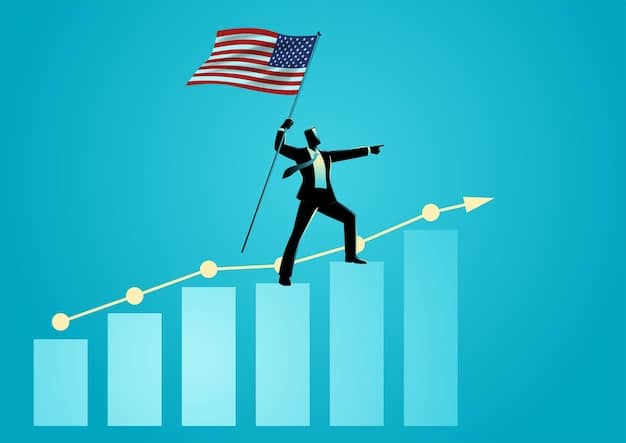US GDP Growth 2025: Job Creation Impact & Economic Outlook

The projected 2.8% GDP growth in 2025 for the US is anticipated to significantly bolster job creation across various sectors, stimulating consumer demand and fostering business expansion, though specific impacts will vary by industry and regional dynamics.
As the economic outlook for 2025 solidifies, a projected 2.8% GDP growth rate for the United States sparks critical questions about its implications for the labor market. Will this growth truly translate into widespread opportunities, or will certain sectors benefit disproportionately? Understanding how the projected 2.8% GDP growth in 2025 will impact US job creation requires a nuanced look at underlying economic currents and potential shifts.
Understanding GDP Growth and Its Connection to Employment
The Gross Domestic Product (GDP) serves as a fundamental barometer of a nation’s economic health, reflecting the total value of goods and services produced over a specific period. When GDP grows, it generally signals an expanding economy, which, in turn, often correlates with increased demand for labor. A 2.8% growth rate, while not a boom, signifies a robust and steady expansion, potentially moving beyond recovery stages for some sectors. This forecast suggests businesses are anticipating higher sales and production needs, compelling them to ramp up their workforces.
Economists often categorize the relationship between GDP growth and employment through models like Okun’s Law, which posits an inverse relationship between unemployment and GDP growth. While not a perfect predictor, it highlights how sustained economic expansion typically leads to a reduction in unemployment rates. For 2025, a 2.8% growth might imply a stable-to-decreasing unemployment rate, depending on factors like labor force participation and productivity gains. The quality of jobs created is also a vital consideration, as not all growth translates into high-wage, high-skill positions.
The Mechanics of Expansion
A growing GDP influences job creation directly and indirectly. Direct impacts come from companies expanding operations, building new facilities, or producing more goods and services, thus needing more workers. Indirectly, increased consumer spending fueled by a stronger economy drives demand across various industries, creating a ripple effect. For instance, more people buying homes leads to more jobs in construction, real estate, and related financial services. The government also plays a role through its spending and fiscal policies, which can stimulate or dampen job creation efforts.
Factors Influencing Job Growth Quality
- Productivity Gains: Advances in technology can increase output per worker, potentially limiting the number of new hires needed for a given level of growth.
- Labor Force Participation: Changes in the number of people actively seeking employment can influence unemployment figures, even with robust job creation.
- Sectoral Shifts: Growth concentrated in highly automated industries might not generate as many jobs as growth in labor-intensive sectors.
- Global Economic Headwinds: International trade tensions or geopolitical events can affect domestic production and, consequently, job creation.
The interplay of these elements will ultimately determine the breadth and depth of job creation stemming from the 2.8% GDP growth. It’s a complex ecosystem where various forces align or diverge, shaping the future of the US labor market.
Sector-Specific Projections: Winners and Watchouts
The overarching 2.8% GDP growth forecast for 2025 acts as a rising tide, but not all boats will be lifted equally. Certain sectors are poised to benefit significantly, experiencing a surge in demand and subsequent job creation, while others might see more modest gains or face ongoing challenges. Understanding these distinctions is crucial for policymakers, job seekers, and businesses alike. Growth drivers often stem from technological advancements, shifting consumer preferences, and strategic national investments.
Technology and Digital Transformation
The technology sector is consistently a leading force in job creation, and 2025 is unlikely to be an exception. Continued investment in artificial intelligence, cloud computing, cybersecurity, and data analytics will fuel demand for skilled professionals. This includes roles for software developers, data scientists, AI/ML engineers, and cybersecurity analysts. The integration of technology across all industries also means that “tech jobs” are no longer confined to the tech sector; manufacturing, healthcare, and retail are increasingly seeking tech-savvy talent.
Healthcare and Life Sciences
Demographic shifts, particularly an aging population, continue to drive robust demand in healthcare. The projected GDP growth will likely translate into increased spending on medical services, pharmaceutical research, and biotechnological innovations. This will create jobs for nurses, doctors, medical technicians, researchers, and administrative staff within hospitals, clinics, and research institutions. Telemedicine and digital health solutions are also expanding, opening new avenues for employment.

Manufacturing and Infrastructure Development
While often seen as a challenging sector, manufacturing is experiencing a renaissance, partly due to reshoring efforts and investments in advanced manufacturing technologies. The 2.8% GDP growth implies increased production, particularly in areas related to clean energy, electric vehicles, and defense. Simultaneously, planned infrastructure projects—repairing roads, bridges, and updating public transit—will generate significant construction jobs, as well as demand for engineers, project managers, and skilled trades.
Emerging Areas to Watch
- Renewable Energy: As the US pushes for sustainability, jobs in solar, wind, and other green energy sectors will continue to expand.
- E-commerce and Logistics: The persistent shift towards online shopping will drive demand for logistics planners, delivery personnel, and warehouse staff.
- Professional and Business Services: Consultants, accountants, marketing professionals, and human resources specialists will be in demand as businesses expand and navigate a complex economic landscape.
Conversely, some sectors, such as traditional retail, might face ongoing challenges from e-commerce competition, requiring adaptation and upskilling rather than significant net job growth. The hospitality sector, while experiencing recovery, might see slower growth depending on travel patterns and consumer discretionary spending. The key will be agility and the ability to adapt to evolving economic conditions and technological disruptions to maximize job creation potential across the board.
Skills Gap and Workforce Development Challenges
Even with a projected 2.8% GDP growth and a clear potential for job creation, the US labor market faces persistent challenges, notably the skills gap. This disconnect between the skills employers need and those possessed by the available workforce can hinder economic expansion and limit the effectiveness of job creation efforts. Addressing this gap requires concerted action from educational institutions, businesses, and government.
The rapid pace of technological change means that skills quickly become obsolete, while new ones are constantly in demand. For instance, the rise of AI and automation necessitates a workforce proficient in data literacy, critical thinking, design thinking, and complex problem-solving. While these skills are broadly applicable, specific technical expertise in areas like advanced analytics, cloud architecture, and cybersecurity remains critically short. This mismatch can lead to unfilled positions even during times of robust economic growth, creating bottlenecks for businesses looking to expand.
Education and Training Initiatives
Bridging the skills gap requires a multi-pronged approach. Educational institutions, from K-12 to universities, must evolve their curricula to better align with industry needs. This includes emphasizing STEM education, incorporating vocational training, and fostering interdisciplinary skills. Beyond formal education, reskilling and upskilling programs are essential for the existing workforce. Businesses can implement in-house training, offer apprenticeships, and partner with community colleges to develop tailored programs. Government initiatives, such as funding for workforce development and tax incentives for employer-provided training, can also play a crucial role.
The Role of Lifelong Learning
- Continuous Learning: Employees must embrace a mindset of lifelong learning to adapt to changing job requirements.
- Micro-credentials: Shorter, focused certifications and badges can provide targeted skills development more quickly than traditional degrees.
- Employer Investment: Companies that invest in their employees’ growth tend to retain talent and build a more adaptable workforce.
- Digital Literacy: Foundational digital skills are now a prerequisite for virtually all jobs, regardless of sector.
Failing to address the skills gap could mean that the opportunities created by GDP growth are not fully realized. Industries might struggle to find qualified candidates, slowing down expansion and potentially leading to slower job creation than the headline growth rate suggests. A proactive approach to workforce development is therefore not just an HR concern, but an economic imperative.
Economic Policies and Their Influence on Job Growth
The projected 2.8% GDP growth in 2025 is not an isolated phenomenon; it’s intricately linked to a complex web of economic policies implemented by the government. Fiscal and monetary policies, trade agreements, and regulatory frameworks all play a significant role in shaping the economic environment and, by extension, the landscape of job creation. Understanding these influences is key to appreciating the potential trajectory of the US labor market.
Fiscal Policy and Government Spending
Fiscal policy, encompassing government spending and taxation, can directly stimulate job creation. Increased government spending on infrastructure projects, research and development, or social programs injects money into the economy, boosting demand and requiring more workers. Tax policies, such as tax credits for businesses that hire new employees or invest in certain technologies, can also incentivize job growth. The balance between stimulating growth and managing national debt is a constant challenge for policymakers.
Monetary Policy and Interest Rates
The Federal Reserve’s monetary policy, primarily through setting interest rates, influences borrowing costs for businesses and consumers. Lower interest rates can encourage businesses to expand and invest, leading to hiring, while also making it cheaper for consumers to buy big-ticket items, boosting demand. A stable and predictable monetary policy environment helps businesses plan for the future, which is conducive to sustained job creation. However, striking the right balance to avoid inflation while encouraging growth is a delicate act.
Trade Policies and Global Integration
- Trade Agreements: Favorable trade agreements can open new markets for US goods and services, stimulating domestic production and job growth.
- Tariffs: While sometimes used to protect domestic industries, tariffs can also increase costs for businesses relying on imported components, potentially hindering job creation.
- Global Supply Chains: Resilient and diversified global supply chains are crucial for consistent production and can indirectly support stable employment.
Regulatory policies also matter, with reforms aimed at reducing unnecessary burdens on businesses potentially fostering an environment more conducive to hiring. Conversely, overly complex or restrictive regulations can deter investment and expansion. The cumulative effect of these policies, in conjunction with the 2.8% GDP growth, will significantly determine the scale and nature of job creation across the US in 2025.
Regional Disparities in Job Creation
While the national projected 2.8% GDP growth for 2025 paints a broad picture of economic health, it’s crucial to acknowledge that this growth, and its resultant job creation, will not be evenly distributed across all US regions. Economic landscapes vary significantly from state to state and even within different metropolitan areas, leading to distinct employment trends and opportunities. Factors like industry concentration, demographics, state-specific policies, and access to resources all contribute to these regional disparities.
Regions heavily invested in burgeoning sectors like technology, renewable energy, or advanced manufacturing are likely to experience more robust job growth. For instance, tech hubs in California, Texas, and Washington, or green energy corridors in the Midwest, might see significant increases in high-skill employment. Conversely, areas still reliant on declining traditional industries might struggle more, even with national economic expansion, experiencing slower job growth or even continuing job losses in specific sectors.
Impact of Localized Investment
Local and state governments play a vital role in fostering job creation through targeted investments and incentives. Policies aimed at attracting new businesses, developing local infrastructure, or funding specific workforce development programs can significantly alter a region’s employment outlook. For example, tax breaks for new factories or grants for small business innovation can create localized economic booms, demonstrating how a 2.8% GDP growth can be amplified or diminished at the local level.
Key Factors Influencing Regional Differences
- Industry Specialization: Regions with strong ties to growth industries will fare better.
- Labor Market Flexibility: The ability of a local workforce to adapt to new demands through training and mobility.
- Cost of Living: High-cost regions might attract high-wage jobs but could struggle with attracting more accessible roles.
- Infrastructure Quality: Robust transportation, communication, and utility infrastructure supports business growth and job creation.
- Demographic Trends: Changes in local population age, education levels, and migration patterns influence labor supply and demand.
Understanding these regional nuances is essential for both individuals and businesses. Job seekers might find better opportunities by aligning their skills with the growth sectors of specific regions, while companies might choose to relocate or expand in areas offering a supportive economic environment and a skilled labor pool. The national GDP growth provides context, but the local details dictate specific outcomes.
Anticipated Impact on Wages and Labor Market Conditions
The projected 2.8% GDP growth in 2025, coupled with robust job creation, is expected to exert noticeable pressure on wages and generally tighten labor market conditions. When an economy expands and demand for labor increases, employers often find themselves competing for talent, which typically translates into higher compensation. This scenario could offer a welcome boost to workers’ purchasing power, though the extent of wage growth will be influenced by several dynamic factors.
A tighter labor market implies that there are fewer job seekers for available positions, shifting some bargaining power towards employees. This can manifest not only in higher base salaries but also in improved benefits packages, greater workplace flexibility, and enhanced opportunities for career advancement. However, the impact on wages is rarely uniform. High-demand skills, particularly in innovative sectors like tech and specialized healthcare, are likely to see the most significant wage increases, while sectors with a more abundant labor supply might experience more modest gains.
Inflationary Pressures and Real Wage Growth
One critical consideration is the interplay between wage growth and inflation. If wages rise substantially, but the cost of living—influenced by inflation—increases at a similar or faster rate, the real purchasing power of workers may not improve significantly. Economic policymakers, particularly the Federal Reserve, will closely monitor these trends to ensure that economic growth remains sustainable without triggering excessive inflation. A 2.8% GDP growth is generally seen as strong but not overheated, suggesting a more balanced scenario for wage dynamics.
Factors Affecting Wage Dynamics
- Productivity Growth: Higher productivity can support wage increases without equivalent inflationary pressure.
- Unionization Levels: Industries with stronger union presence may see more consistent wage growth.
- Minimum Wage Policies: State and federal minimum wage increases can impact the lowest earners.
- Global Competition: International labor market dynamics can influence wages in globally integrated industries.
- Automation: While automation can displace some jobs, it can also create new, often higher-paying, roles requiring specialized skills.
Ultimately, 2025’s projected GDP growth indicates a generally positive outlook for labor market conditions and wage trends. While some sectors and skill sets will undoubtedly benefit more than others, the overall environment is likely to favor employees, offering more opportunities and potentially improving their economic standing. Businesses will need to strategize carefully on attraction and retention, understanding that competitive compensation and a positive work environment will be key.
Long-Term Economic Resilience and Future Outlook
The projected 2.8% GDP growth in 2025 not only signals a positive short-term economic outlook but also contributes to the longer-term economic resilience of the United States. Sustained growth fosters an environment where businesses are more likely to invest in research and development, innovate new technologies, and expand their global footprint, all of which are critical for future prosperity. This momentum helps build a more robust economy capable of withstanding future shocks and adapting to new global challenges.
Economic resilience is not just about GDP numbers; it’s about the underlying strength of an economy’s structures. Diversified industries, a skilled and adaptable workforce, robust infrastructure, and sound financial systems all contribute to this capacity. The job creation stemming from 2025’s growth will likely strengthen these components, as new industries emerge, existing ones modernize, and more people gain valuable experience and skills. This positive feedback loop is crucial for enduring economic health.
Innovation as a Driver of Long-Term Growth
Innovation often flourishes during periods of sustained economic growth. Businesses, with greater resources and confidence, are more inclined to take risks on new ideas and technologies. This translates into advancements in various fields, from healthcare and clean energy to artificial intelligence and space exploration. Each innovation cycle creates entirely new industries and job categories, ensuring that the economy remains dynamic and capable of expanding beyond traditional sectors.
Pillars of Future Economic Strength
- Technological Leadership: Continued investment in R&D and fostering a culture of innovation.
- Human Capital Development: Prioritizing education, reskilling, and lifelong learning for the workforce.
- Sustainable Practices: Integrating environmental and social responsibility into economic models.
- Global Competitiveness: Maintaining an open and fair trade environment while protecting strategic industries.
- Fiscal Prudence: Managing government finances responsibly to ensure long-term stability.
Looking beyond 2025, the foundation laid by this growth phase can set the US on a path of continued economic stability and opportunity. It allows for critical investments in infrastructure, education, and public services that underpin societal well-being and future economic potential. The decisions made during this period of growth will shape the economic landscape for decades to come, defining both the challenges and opportunities that lie ahead for US job creation and prosperity.
| Key Area | Projected Impact on Job Creation |
|---|---|
| 📈 GDP Growth | A 2.8% growth rate is expected to drive overall job creation by increasing business demand. |
| 💡 Key Sectors | Technology, Healthcare, and Manufacturing/Infrastructure are poised for significant job gains. |
| 🧑🎓 Skills Gap | Persistent challenge; workforce development and continuous learning are crucial to fill new roles. |
| 💰 Wages & Conditions | Labor market tightening expected to lead to wage growth, especially for high-demand skills. |
Frequently Asked Questions About 2025 US Job Growth
For average job seekers, a 2.8% GDP growth typically means more available positions and potentially better opportunities for wage growth. Businesses, experiencing higher demand, will hire more, leading to a more competitive job market where employees have slightly more leverage in negotiations for salaries and benefits.
Industries projected to benefit most include technology (AI, cloud, cybersecurity), healthcare (due to an aging population and advancements), and manufacturing/infrastructure (driven by reshoring and public investments). Renewable energy and professional services are also expected to see robust growth in job creation.
Yes, the skills gap remains a significant concern. Even with a healthy GDP growth, if the workforce lacks the specific skills needed for new, technology-driven roles, job creation can be hampered. Continuous education, reskilling programs, and employer investment in training are crucial to mitigate this challenge.
Government fiscal policies (spending, taxation) and the Federal Reserve’s monetary policies (interest rates) significantly impact job creation. Supportive policies that encourage business investment, consumer spending, and workforce development can amplify the positive effects of GDP growth on employment figures.
Beyond immediate job creation, sustained 2.8% GDP growth fosters long-term economic resilience. It encourages innovation, investment in critical infrastructure, and strengthens human capital through skill development. This lays a stronger foundation for future economic stability, adaptability, and prosperity across various sectors.
Conclusion
The projected 2.8% GDP growth for the US in 2025 represents more than just a statistical uptick; it signals a dynamic phase for the nation’s labor market. While certain sectors like technology, healthcare, and infrastructure are poised for significant job creation, navigating the existing skills gap and ensuring inclusive growth will be paramount. Through strategic policy-making, continuous workforce development, and a keen understanding of evolving industry needs, the US can harness this economic momentum to foster a resilient and opportunity-rich job market for its citizens in the coming years.





